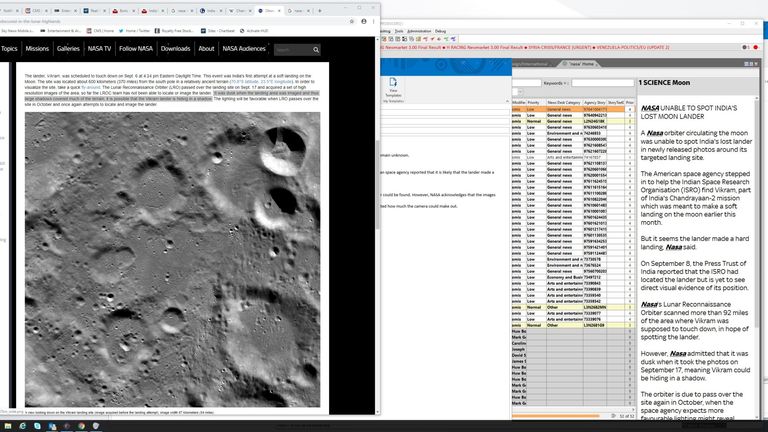Vikram moon lander: NASA finds lost Indian spacecraft with help from amateur astronomer
NASA initially suggested that the lander could have simply been "hiding in a shadow" of one of the major lunar craters
NASA has found a lost lunar lander launched by the Indian space agency in September - with help from an amateur astronomer.
The Indian Space Research Organisation (ISRO) lost touch with the Vikram lander as it approached the moon's south pole earlier this month, and it was not clear whether it had crashed or landed.
NASA initially suggested that the lander could have simply been "hiding in a shadow" of one of the major lunar craters.
The space agency's Lunar Reconnaissance Orbiter scanned more than 92 miles of the area where the lander was supposed to touch down, but failed to find it.
However, NASA said it was dusk when it took the photos, with large shadows "covering much of the terrain", and that it "is possible that the Vikram lander is hiding in a shadow".
The Chandrayaan-2 mission, which has cost roughly $140m (£114m), was intended to study the permanently shadowed moon craters for signs of water, confirmed by India's Chandrayaan-1 mission more than 11 years ago.
Despite its disappearance, work from a 33-year-old Indian IT professional from Chennai, Shanmuha Subramanian, managed to identify the spacecraft's debris field scattered over several kilometres.
"I had side-by-side comparison of those two images on two of my laptops... on one side there was the old image, and another side there was the new image released by NASA," Mr Subramanian told the AFP news agency.
Explaining how he was assisted by fellow amateur astronomers on social media, he said: "It was quite hard, but [I] spent some effort."

news.sky.com
This post is for sharing knowledge only, no intention to violate any copy rights
NASA initially suggested that the lander could have simply been "hiding in a shadow" of one of the major lunar craters
NASA has found a lost lunar lander launched by the Indian space agency in September - with help from an amateur astronomer.
The Indian Space Research Organisation (ISRO) lost touch with the Vikram lander as it approached the moon's south pole earlier this month, and it was not clear whether it had crashed or landed.
NASA initially suggested that the lander could have simply been "hiding in a shadow" of one of the major lunar craters.
The space agency's Lunar Reconnaissance Orbiter scanned more than 92 miles of the area where the lander was supposed to touch down, but failed to find it.
However, NASA said it was dusk when it took the photos, with large shadows "covering much of the terrain", and that it "is possible that the Vikram lander is hiding in a shadow".
The Chandrayaan-2 mission, which has cost roughly $140m (£114m), was intended to study the permanently shadowed moon craters for signs of water, confirmed by India's Chandrayaan-1 mission more than 11 years ago.
Despite its disappearance, work from a 33-year-old Indian IT professional from Chennai, Shanmuha Subramanian, managed to identify the spacecraft's debris field scattered over several kilometres.
"I had side-by-side comparison of those two images on two of my laptops... on one side there was the old image, and another side there was the new image released by NASA," Mr Subramanian told the AFP news agency.
Explaining how he was assisted by fellow amateur astronomers on social media, he said: "It was quite hard, but [I] spent some effort."

news.sky.com
This post is for sharing knowledge only, no intention to violate any copy rights